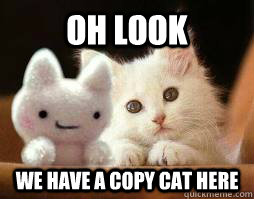Our Inside SEER series cracks open SEER's internal resource archives to share our best practices with others.The latest post in this SEERies shares our team's insights on the issue of copyright infringement. You'll discover what tools you can use to protect yourself against plagiarized copy and what channels to go through to help restore your rankings and reputation on the web.
What Is Copyright Infringement and Why Does it Suck?
Copyright infringement is the “real world” equivalent of looking over your 5th grade buddy’s shoulder and copying her answers on your Friday vocab quiz. Even if your classmate -- we’ll call her Hermione -- is okay with you copying her answers, your teacher will not be pleased.
Think of Google as your teacher: stern, yet fair -- and equipped with years of experience in dealing with those who do not do their homework and attempt to pass off the hard work of others as their own.
That’s right. Professor Minerva McGonaGoogle is far too smart to let a student pull the wool over her eyes. Most of the time, she knows who has put in the work to gain a greater understanding of the subject matter and who is playing copycat with their classmates.
While copying a classmate’s answers may merit a parent-teacher conference or (if you attend Hogwarts) find you temporarily transfigured into a fuzzy weasel as punishment; copying the work of others on the Internet holds a much steeper penalty.
In the best case scenario, you run the risk of seeing your website tank in the SERPs because Google is unsure which piece of content is the original version. (Think of it as both you and the person you've been copying from getting a semester's worth of detention.)
The worst case scenario can result in a lawsuit. (Just ask Vanilla Ice!)

The Ethical Considerations of Copyright Infringement
Not everyone is aware that they’re working with content that’s been copied from somewhere else on the web. It’s one thing for a writer to quote a few lines from an authoritative source and give that quote proper attribution. However, it’s a whole other ball of borrowed bass lines when entire paragraphs have been lifted from a creditable source without a.) proper attribution or b.) attempting to convey sourced information in their own words.
Most writers -- either in-house or freelance -- take a great deal of pride in their work and adhere to a strong code of ethics. However, you will occasionally work with the odd writer who will copy-and-paste the work of others to make a quick profit.
That’s just one half of the equation, however. While you, as an editor and SEO, should always do a quick spot check on Google to ensure that the content created on your client’s behalf is original, sometimes, other writers are using your site as the authoritative source and stealing your original web content for their own diabolical purposes. This can also put your site at risk for a duplication penalty. (Womp-womp.)
Tools for Detecting Copyright Infringement and Plagiarism
Many site owners remain blissfully unaware that their content has been misappropriated by others -- until they discover that another site is outranking them. (Dun-dun-DUN!)
Fortunately, there are a number of free tools you can use to ensure that the content created for your clients is original or that other sites aren’t taking your content and using it for their own nefarious purposes elsewhere on the web. Here are a few tools you can use to keep copyright infringement issues at bay.
1. Copyscape
Copyscape offers a free version of its services to help editors, site owners, and others involved in the creation and publishing of content to determine whether that content is original or if it appears elsewhere on the web. To use, simply plug in the URL you want to check for copy and Copyscape will turn up results of pages that may be lifting passages of your site’s content. Signing up for Copyscape can help you stay on top of any new incidents of copyright infringement across the Internet.
2. Google Scraper Report
Matt Cutts, head of Google’s web spam division, recently announced the creation of a new Google tool that allows concerned netizens to provide the search engine with the URL of their original content and the URL of the site that they surmise has lifted their content. This tool offers site owners a faster mode of recourse than reporting copyright infringement to Google Legal Support. The new Google Scraper Report potentially aims to solve the issue of duplicate content faster than its older, legal-rooted counterpart by classifying plagiarized content as a spam issue, rather than one of copyright infringement or intellectual property. Legal issues can often be sticky and time consuming. And your site’s rankings may continue to take a nosedive while the matter is tied-up in litigation. By reporting the problem of scraped content as a spam issue, Google hopes to resolve issues faster.
3. WhoIs
Another approach you can take to remedying the issue of copyright infringement is to use the website WhoIs.com to find out who hosts the site in question. WhoIs can provide you with the contact information of the website’s hosting company. From there, you can let them know of the violation. The hosting company should respond by shutting down the website.
Hopefully, you will never run into the issue of your content standing on either side of the copyright infringement fence. However, if that day ever comes, you have the ammo you need to restore your site's good reputation -- and rankings!



